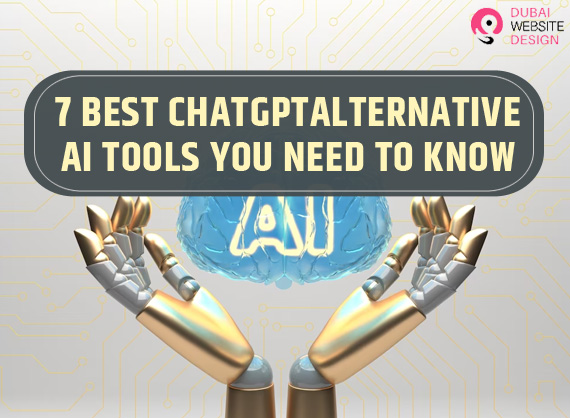Explore seven powerful AI tools as alternatives to ChatGPT, each offering unique functionalities and enhancing your AI projects. Find the perfect fit for your needs.
The need for AI-powered technologies has significantly increased in recent years. Businesses and developers are using AI technologies to automate processes, improve consumer experiences, and spur creativity. These technologies range from natural language processing to chatbot applications.
OpenAI’s ChatGPT, which was created, has gained widespread recognition for its capacity for conversation and language production. However, it’s crucial to investigate other AI technologies that provide special features and address certain use cases. We’ll present you seven of the greatest ChatGPT substitute AI tools in this post, each of which has a special benefit and broadens your AI toolbox.
OpenAI GPT-3: Power and Versatility
One of the most effective language models currently available is OpenAI GPT-3. GPT-3 is built to tackle challenging natural language processing jobs with amazing accuracy and has a mind-boggling 175 billion parameters.
Like ChatGPT, it is based on the transformer architecture, but due to its size and ability to comprehend context, it can carry out a variety of activities, such as text production, chatbot building, and language translation and summarization.
Microsoft Azure Language Understanding (LUIS): Understanding User Intentions
An AI technology called Microsoft Azure Language Understanding (LUIS) is focused on deciphering human intents. It enables programmers to create software that can comprehend user input in natural language and communicate with people in a more human-like way.
LUIS is perfect for developing conversational interfaces such as chatbots, virtual assistants, and others that can provide tailored replies and fluid human-computer interactions.
IBM Watson Assistant: Building Powerful Chatbots
A flexible chatbot platform called IBM Watson Assistant enables companies to create and use AI-powered virtual assistants. With its sophisticated features, like machine learning and natural language processing, Watson Assistant can tackle challenging questions and deliver precise answers in real time.
It is frequently utilised in many different businesses to improve customer service, automate procedures, and provide individualised website designs.
Google Cloud Natural Language API: Advanced Language Analysis
A useful substitute for ChatGPT, Google Cloud Natural Language API provides a variety of language analysis features. It can do entity recognition to find named entities, sentiment analysis to comprehend the emotions represented in text, and content classification to group text according to its subject matter.
These tools may be included by WordPress developers in their apps to glean useful information from unstructured text data.
Wit.ai: Creating Conversational Interfaces
Wit.ai, which Facebook purchased, specialises in creating conversational user interfaces for a range of platforms, including chatbots, mobile applications, and smart gadgets. Developers can design more interesting and dynamic conversational experiences because of their natural language processing capabilities.
Wit.ai is a popular option for developers looking to create AI-driven chatbots and voice-based website designs due to its flexibility and ease of use.
Rasa: Customizable AI Framework
Rasa is an open-source artificial intelligence platform that emphasises chatbot creation and NLU. Its stands apart because of its focus on control and customisation.
Developers have more freedom in adjusting chatbot behaviour since they can train AI models using their data. Because Rasa gives you entire control over your chatbot’s replies, it appeals to enterprises with particular needs.
Dialogflow: Google-Powered Chatbot Development
A popular platform for building chatbots and interactive voice response (IVR) systems is Dialogflow, which is powered by Google Cloud.
For WordPress developers looking for a smooth experience, its user-friendly design and connectivity with other Google services make it a top pick. Building and deploying AI-powered conversational apps is made simple with Dialogflow’s built-in templates, NLU capabilities, and a variety of integration choices.
Considerations for Selecting an AI Tool
To choose an alternative AI tool to ChatGPT and make sure it meets your requirements, take into account the following aspects:
- Functionality: Consider if the tool’s capabilities align with the goals and tasks you wish to achieve with AI.
- Scalability: Take into account if the tool can manage the escalating needs for AI and complicated activities as your projects grow.
- Integration: To guarantee a smooth installation process, evaluate how effectively the product connects with your current systems and platforms.
- Search for technologies that let you alter AI models and replies so that you may communicate with users in a more personalised way.
- Cost-effectiveness: Take into account the tool’s price model and overall value proposition.
Diversify Your AI Toolkit for Maximum Impact
Even though ChatGPT has become a popular AI tool, looking at alternatives might provide your AI projects with more options and capabilities. The seven ChatGPT substitute AI technologies discussed in this article each have particular advantages and features that are tailored to certain use cases and demands.
You may make an informed choice and efficiently extend your AI toolbox by taking into account aspects like functionality, scalability, integration, customisation, and cost-effectiveness. Accept the wide range of AI technologies available and take advantage of their potential to promote innovation, improve user experiences, and help you reach your corporate objectives.

